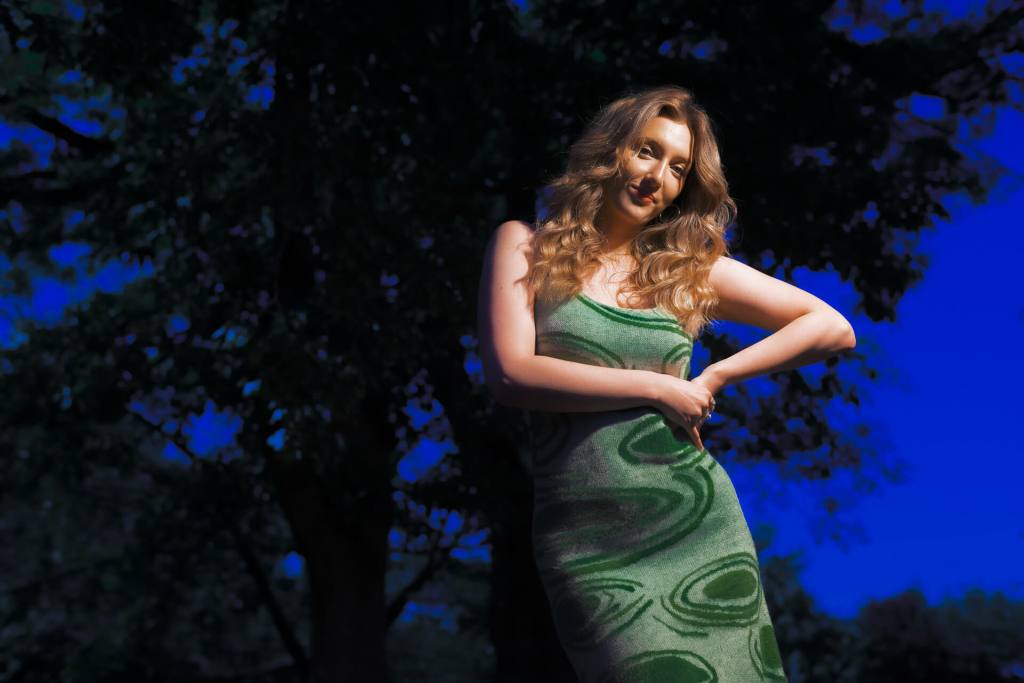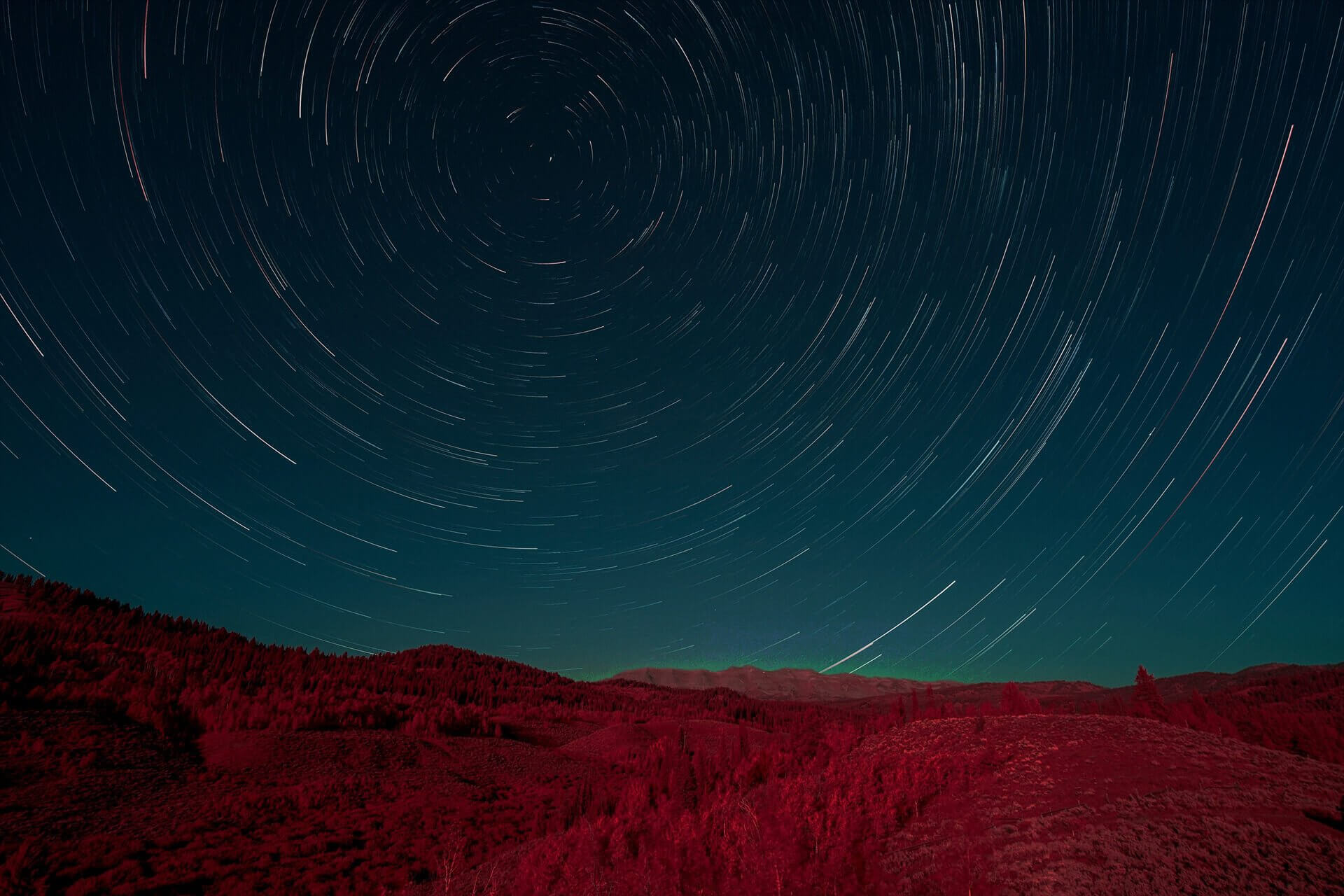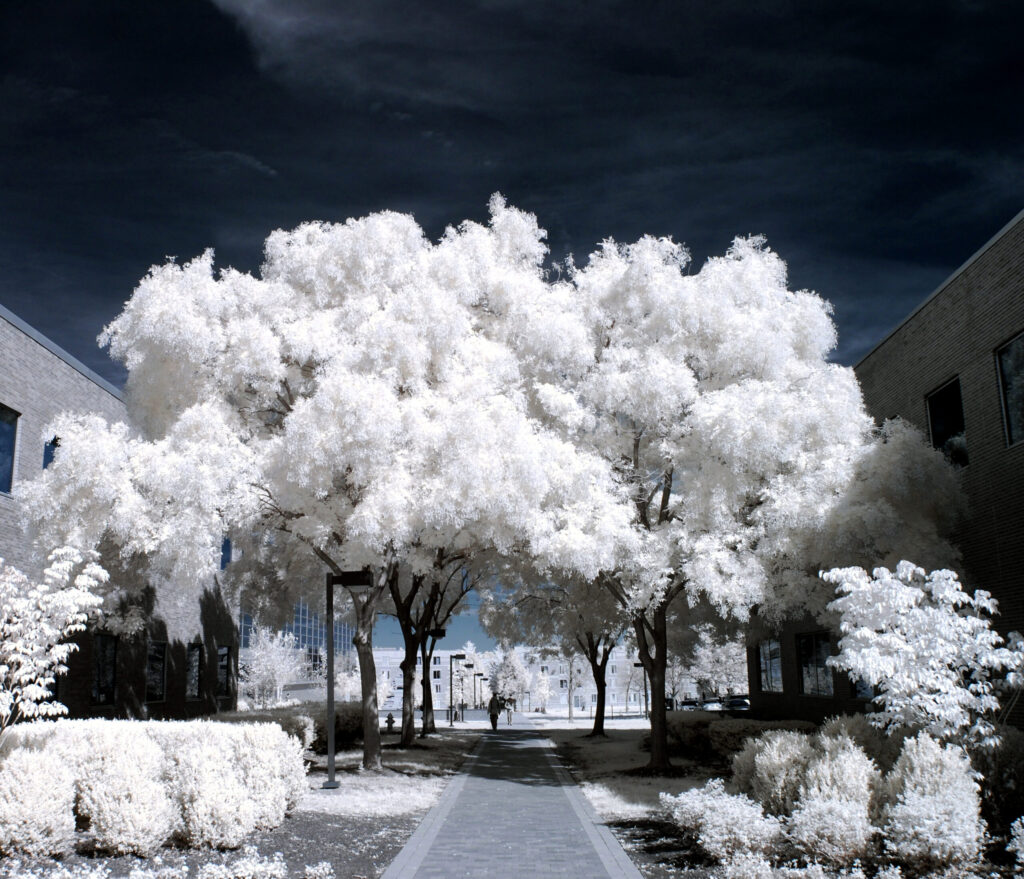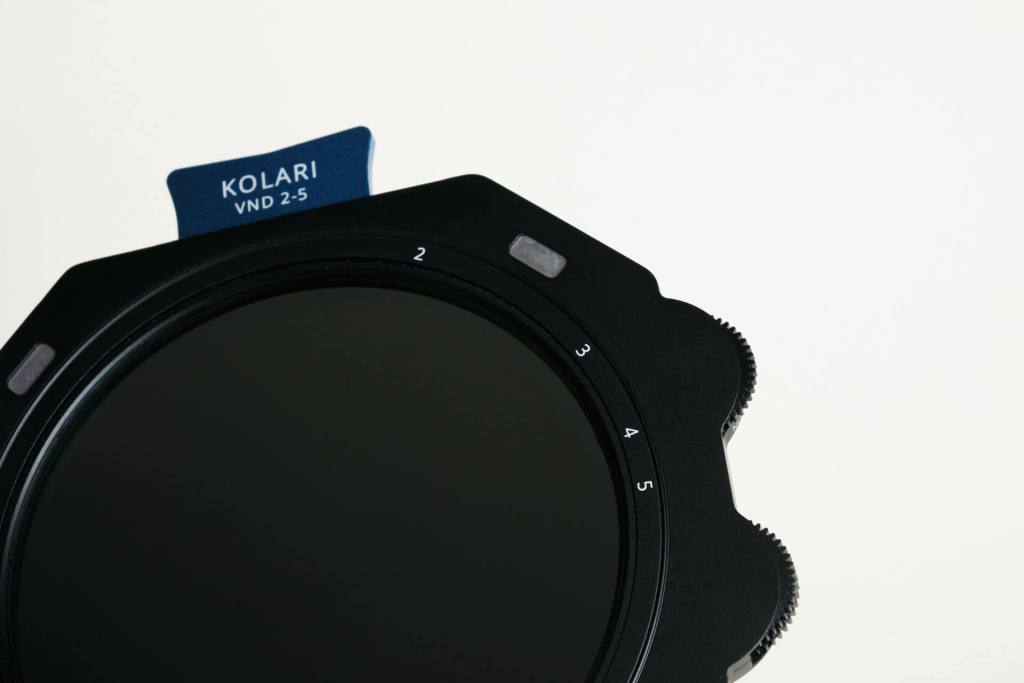What are infrared hotspots?
If you’ve ever shot infrared photography, you’ve probably run into hotspots before, and they probably ruined more than a few of your shots. If you haven’t seen them, a hotspot is a bright spot that forms in the center of the image. In general, some lenses form hotspots, while some do not. Hotspots will get more intense at smaller apertures, and are usually not present at wider apertures. On some lenses the hotspot is very aggressive and the lens is not usable at any apertures, on some the hotspot is mild and is only present at borderline apertures. There has been a lot of community efforts to share which lenses work well and which do not. We compiled a
comprehensive list of feedback on lens performance, but there is a lot of conflicting reports because even at any given aperture, hotspots only appear in some conditions. So while there was a lot of mixed reports, one thing that seemed clear was that hotspots were a lens specific issue.
Are hotspots caused entirely by the lens?
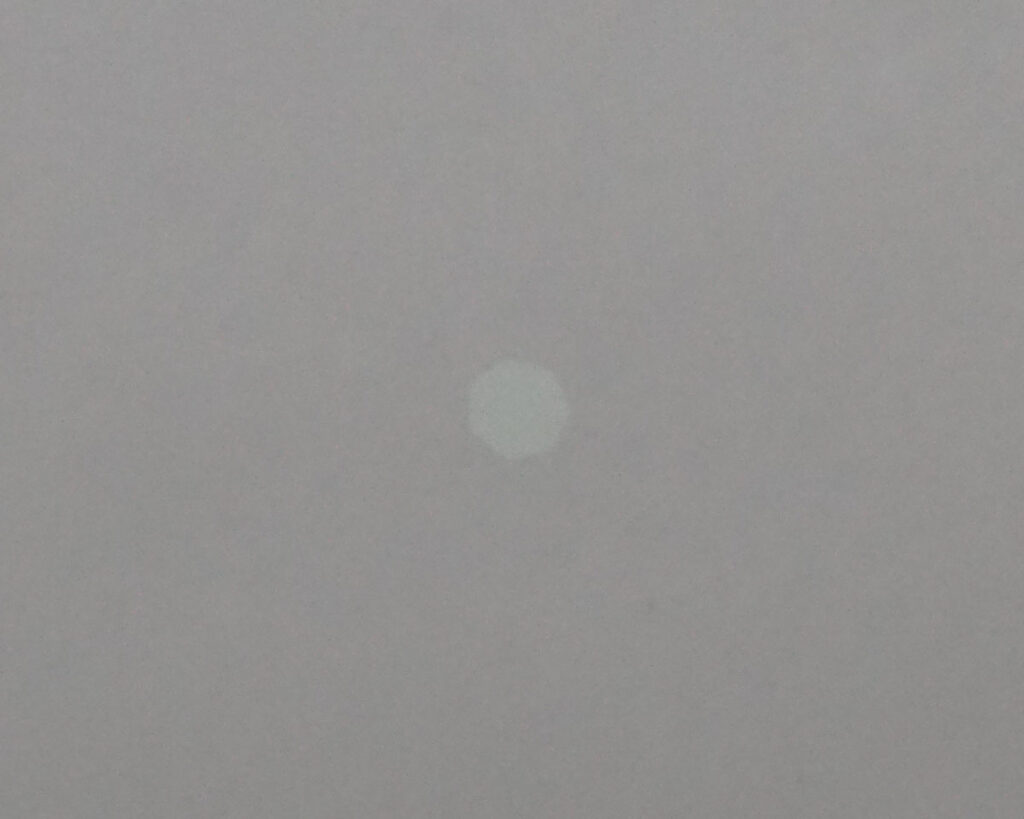
Look familiar? This isn’t an infrared hotspot, it’s actually a visible light hotspot with the Minolta 50mm f/2.8 AF Macro lens.
In 2015 our good friend Tony Kurdzuk pointed out an interesting fact that turned this hypothesis upside down. Being an early adopter of digital, he remembered that early stock digital cameras could sometimes form a hotspot with lenses that were fine with film. This blew our mind; it’s hard to visualize how a sensor reflection could form a focused spot. It seems unintuitive, but when we researched it, there were other reports of this phenomenon. We found one article where the Minolta 5D exhibits a visible light hotspot with certain lenses: Hotspots on early digital cameras. We found other observations that the
color of the hotspot was different between cameras, suggesting that different sensor layers were contributing more than others. Mark Hilliard has also observed that many hotspot causing lenses never made hotspots when shooting film. Compared to film, a digital sensor is highly reflective, and it seems like this was potentially causing hotspots. With this evidence, we reasoned that it was possible to reduce hotspots by reducing reflections at the sensor.
Anti reflective coating
Our first approach was to try to apply AR (anti reflective) coatings onto the filter glass that we install during a conversion. Uncoated glass typically reflects about 4% of light when the light hits the front of the glass, and another 4% when the light hits the back of the glass. With an AR coating, this can be reduced down below 1%, essentially removing all of the reflections from this glass.

When we tested these filters, we found that we were able to reduce hotspots on some lenses, but they were not eliminated. Some lenses would start to show hotspots at later apertures, or in less conditions, but they were ultimately still present in some conditions. We released these AR coated filters in 2016, and feedback from our independant testers were great. Yes, the hotspots were still present, but many lenses had an expanded working range that made them usable in standard shooting conditions. We weren’t quite satisfied and were sure there was more that could be done. For the last two years we have been testing the hotspots in more detail to really understand what causes them and if there is anything that we can do to truly eliminate them. These are our findings
Digital Sensor Architecture
While we were able to reduce the reflections from the IR filters that we install, the rest of the sensor remains unchanged. It is important to consider all of the components of a sensor. This diagram is a simplification, but the hotmirror/infrared filter that sits over the sensor is just one of several layers. Below this layer is a clear protective window that protects the sensor, which has 2 additional reflective surfaces. Below that is the sensor itself, which also has at least one reflective surface (the bare sensor is a complicated assembly of microlenses, a Bayer CFA grid, and photosensors, but we will assume that they are optically fused and act as one reflective surface).
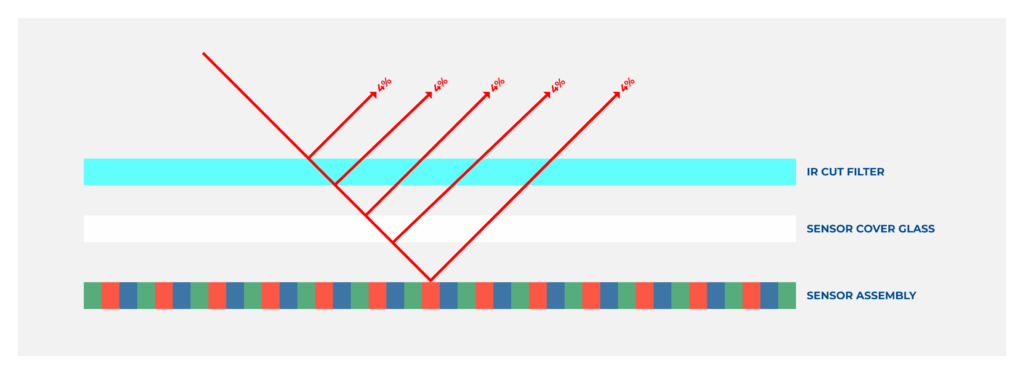
In this context, it becomes apparent that adding an AR coating to the top layer still leaves a lot of reflective surfaces. While we were able to reduce the >90% of the reflection off of the top layer with the AR coating, we have only reduced the total reflections by about 30%. We took apart a sensor to examine how bad the reflections actually were, and we found that while a modern sensor is not highly reflective in visible light, it is still highly reflective in infrared.
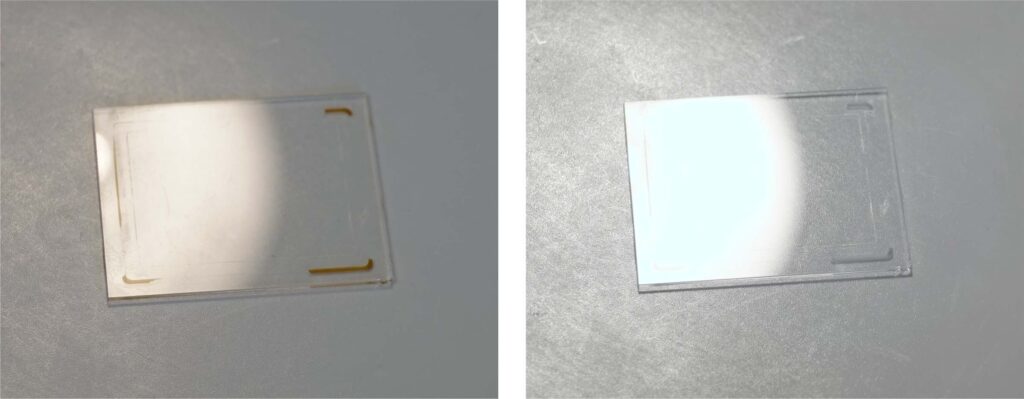
Here is the coverglass layer, shot in visible on the left and infrared on the right. In IR the reflections are much more prominent.
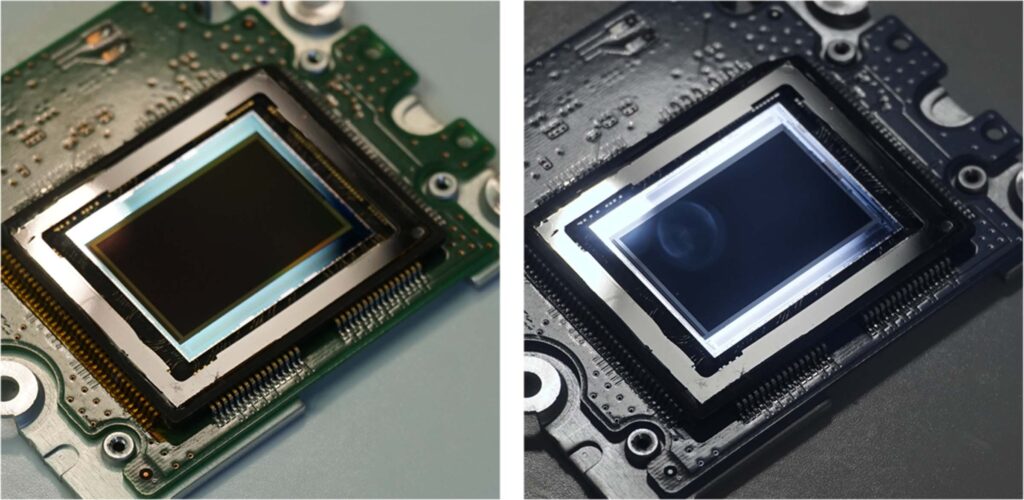
Here is the bare camera sensor, shot again in visible on the left and infrared on the right. You can see a dramatic difference in reflection; under visible light the sensor has no observable reflections. In IR, the sensor is highly reflective.
6 Factors that affect hotspot intensity
Infrared photographers still debate over hot-spots’ true cause and the best way to cure them, but with so many variables influencing whether or not your photos came out with hot spots or not, a solid conclusion was never drawn. Lens, aperture, focus point, camera angle relative to light source, brightness of the scene, and other factors have all been a part of the collective speculation. The internet provides conflicting accounts on most of these variables, so we decided to put them to the test and see which factors actually matter.
1. Lens
This remains the biggest factor. Some lenses are flawless, while the worst ones have a hotspot at all apertures. The Sigma 16mm f/1.4 is one of the worst lenses we have tested and has a hotspot at virtually all hotspots. The Zeiss 50mm f/2, however, never makes a hotspot.
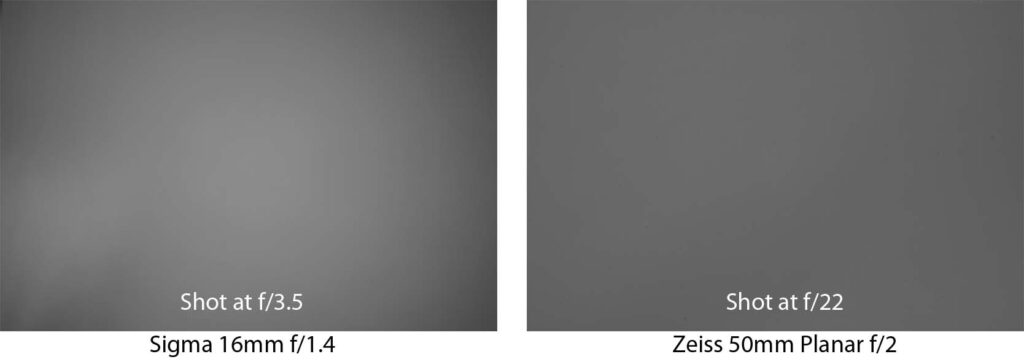
2. Aperture
Another big factor. Without fail, if a lens has any hotspot issues they are more mild wider open and more pronounced at small apertures.

3. Focal Length
For a zoom lens, different focal points have different hotspot intensity. For the Sony 18-55mm we tested, the hotspot was most prominent at 18mm for example. With the 55-210mm, it was most prominent at 55mm. When describing the hotspot characteristics of a lens it is important to note the focal length. For our testing, we chose the focal point with the most prominent hotspot.
4. Focus Point
Even at the worst focal length and aperture, the focus point affects hotspot intensity. Some lenses conveniently only have a hotspot at macro ranges, but most tend to have them in more common ranges. For landscape photographers utilizing large depth of field, you may have enough depth of field to be able to de-focus the hotspot while keeping the image in focus. For our testing, we used the focus point that maximized the hotspot when comparing lenses.
5. Lens angle relative to light source
We always thought this was a big factor, that the angle of the light to the lens affects the hotspot intensity. But when we tested this in detail, we found it has little to no affect on hotspot intensity.
6. Light intensity in the scene
We found that the amount of light in the scene drastically affected hotspot intensity. We used a projector screen to provide even white illumination, and used charcoal foam to mask increasing parts of the screen. The less light there was in the scene, the less pronounced the hotspot got.

Methodology for testing a hotspot
Considering all of these factors above, we’ve devised a test to really visualize how severe and intrusive a hotspot would be. Using a given lens, we chose the focal length and focus point that made the worst hotspot, and tested a range of apertures with the hotspot just slightly over our black mask. We moved the mask over so that it covered slightly more, and tested the same set of apertures below. Then again with the mask further, until the mask covered the whole frame. It is quite labor intensive, but when we arranged all of these pictures, we got a nice perspective on how prevalent a hotspot is. Here is the results with a standard uncoated infrared filter.
Sony FE 28-70 f/3.5-5.6 uncoated conversion filter
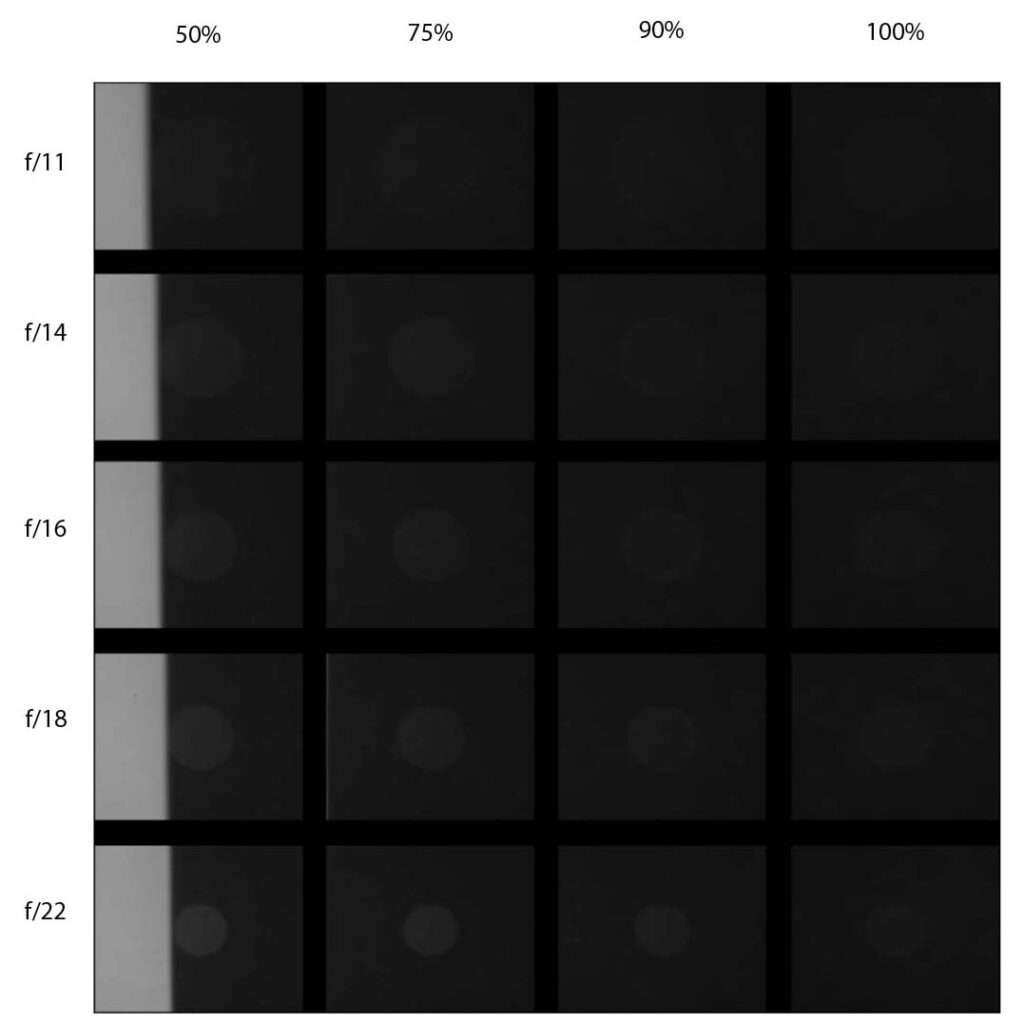
Going from top to bottom, the aperture gets smaller and the hotspot gets more pronounced. Going from left to right, the light decreases and the hotspot gets dimmer. This should produce a rough triangle of conditions with visible hotspots. The bigger this triangle, the more common and noticeable a hotspot will be. Below is another test with our AR coated filter. While the reduction is modest in the left most column, looking at the rest of the pictures it is quite obvious how much the useable range of the lens has improved.
Sony FE 28-70 f/3.5-5.6 AR coated conversion filter
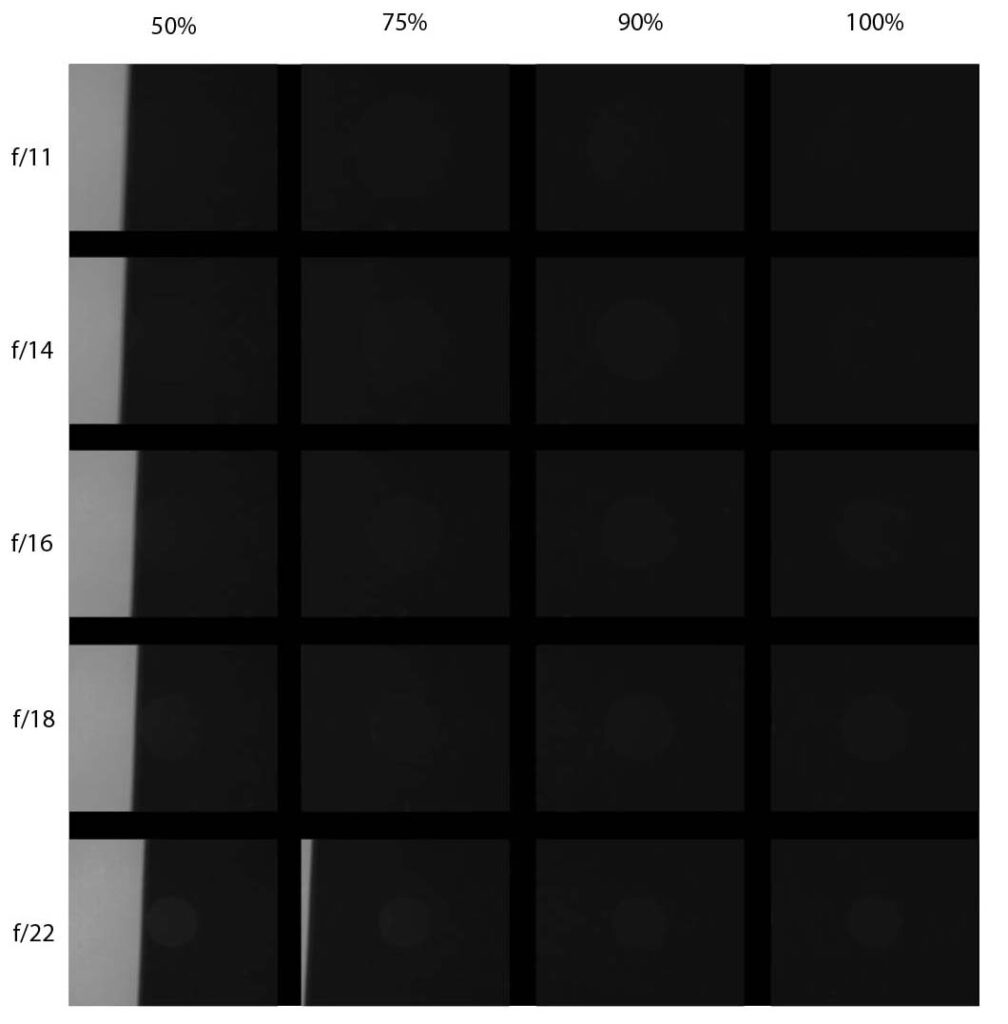
Experimentally testing whether sensor reflections cause hotspots
We were pretty certain that sensor reflections were contributing to hotspots, but that wasn’t scientific enough for us. In science, you propose a hypothesis and then conduct experiments that either support or disprove your hypothesis.
There were three possibilities.
- Stray light coming from out of frame strikes the lens in a way that causes stray reflections resulting in a hotspot
- Light from within the frame bounces around the lens elements or lens barrel, and gets focused by the aperture into a hotspot
- Light bounces back from the sensor into the lens, and gets reflected back towards the sensor where it gets focused by the aperture into a hotspot.
Again, the 3rd possibility is hard to conceptualize, so we really wanted to be sure this was the case. So how do we test where the hotspots come from? We have observed previously that the amount of light in an image affects hotspot intensity. We set up the camera on a tripod, and shot a white screen. As we mask the screen with a black foam, the hotspot intensity gets reduced (we will describe this test in more detail later). We don’t change any of the stray light yet the hotspot intensity decreases, suggesting that only the light the lens is collecting directly matters. We then asked, can we reduce the hotspot by masking the sensor? We put together a simple but effective mask using electrical tape that would cover most of the sensor except for the very center where a hotspot was.
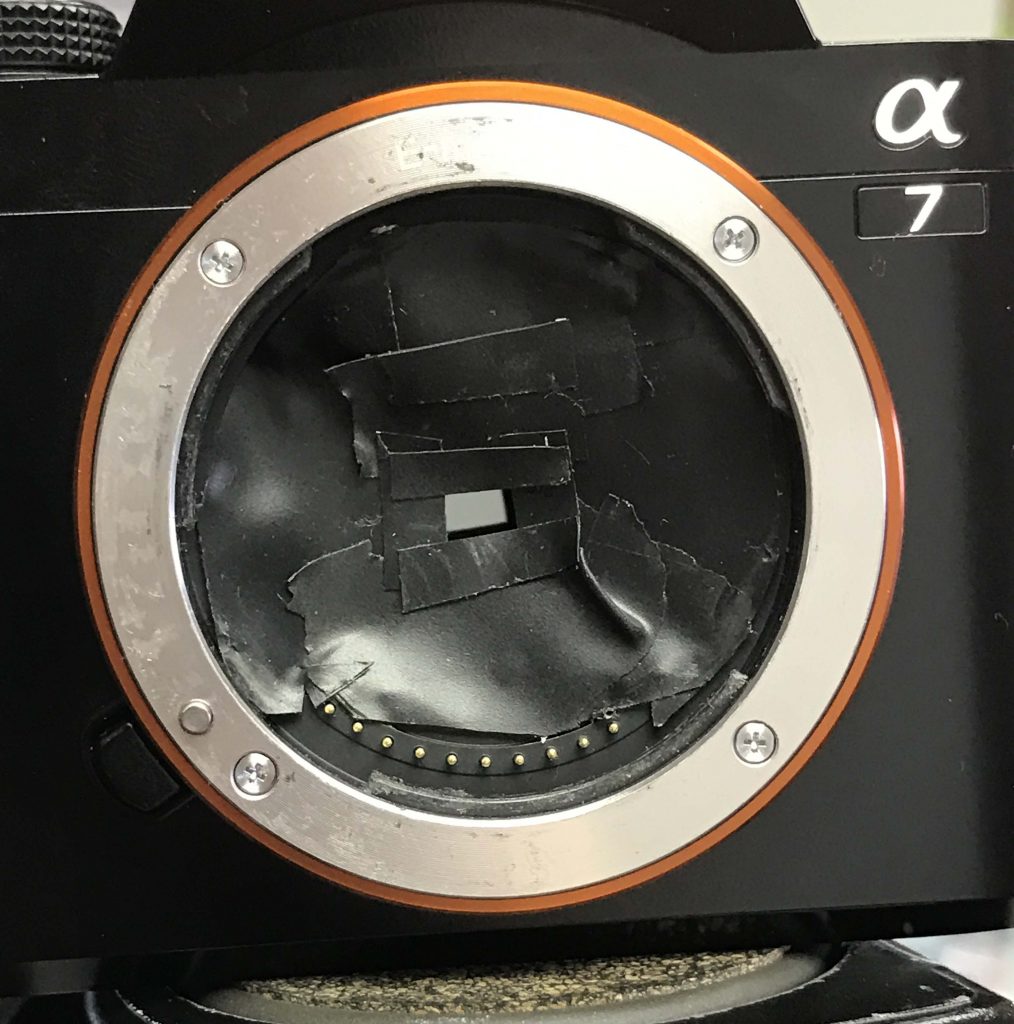
Since the hotspot is a focused spot, we reasoned that if the hotspot originated in the lens and focused onto the center of the sensor, the mask would not do anything to block this light, and the hotspot would look the same. If the hotspot originates as sensor reflections, this mask would block most of the reflections coming from the sensor and reduce the hotspot. We observe the latter, and the sensor mask is able to reduce hotspots.
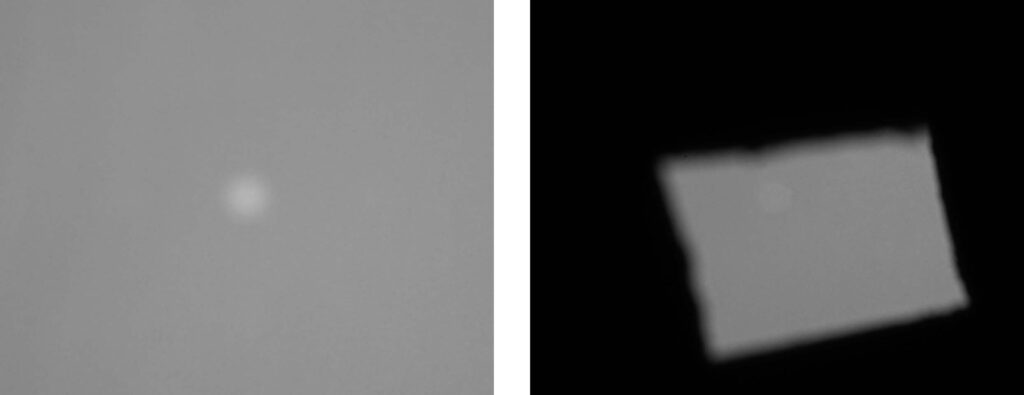
Here you can see our results. Keeping the aperture and exposure consistent, the hotspot intensity is reduced by the sensor mask.
Eliminating Hotspots
With the knowledge that hotspots can be reduced by cutting down sensor reflections, we developed and tested a new filter to see if we could eliminate hotspots. Below, we compare a camera converted with an uncoated filter, our AR coated filter, and our new patent-pending HSK filter. We cropped the photos to show the area of interest. To address whether there were any partial reductions in a hotspot that may not be obvious to the eye, we measured the light intensity across the frame to and graphed the brightness of the hotspot.
Nikon AF-D 50mm f/1.8
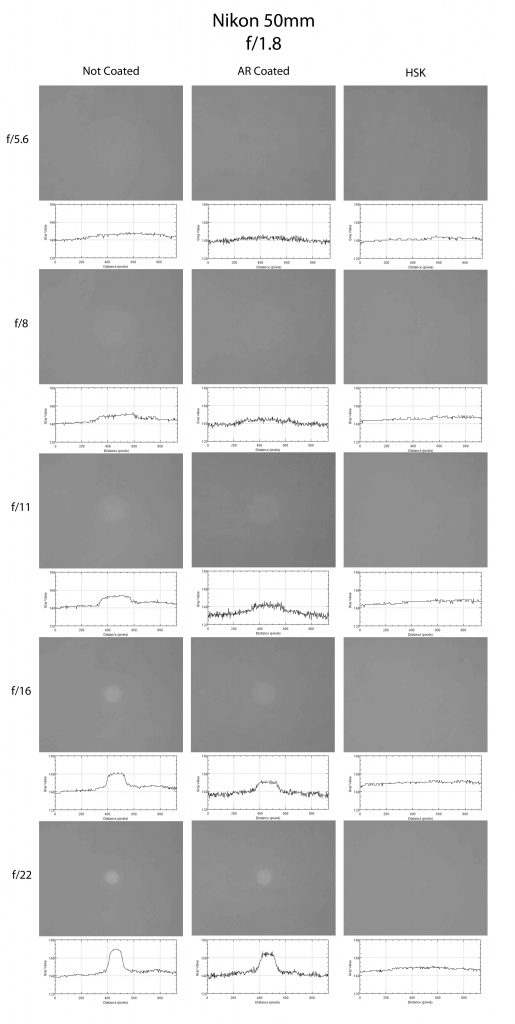
Comparing the not coated camera to the AR coated camera, you can see a clear improvement with the AR coating in the wider apertures. At smaller apertures, both have a visible hotspot, but looking at the line graph shows that the hotspot is still less intense in the AR coated version. But more importantly, ladies and gentlemen, we present to you a fully eliminated hotspot with the HSK filter! Even at f22, this lens has no trace of a hotspot.
Sony SEL-55210 55 – 210mm f/4.5-6.3 OSS
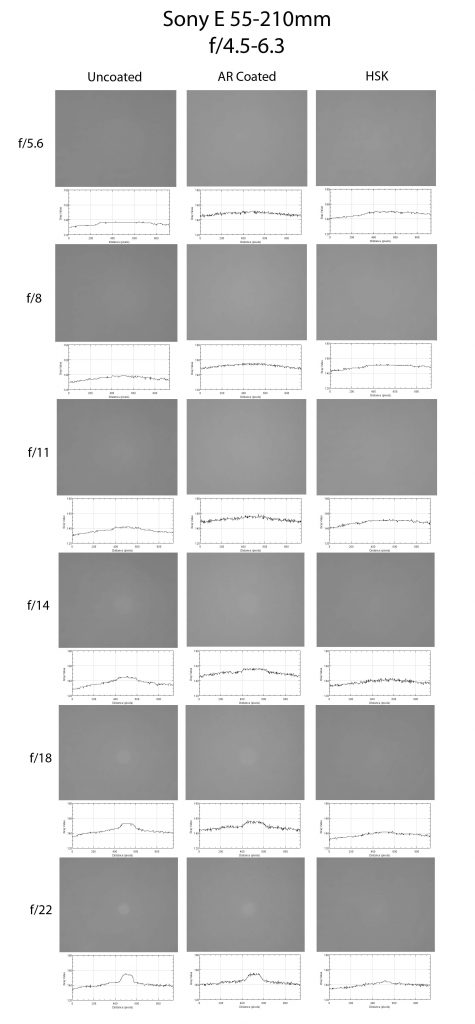
Here the AR coating does not show much improvement, but the hotspot is gone with the HSK filter.
Sony SEL-1855 18-55mm f/3.5-5.6 OSS

With this lens, the HSK didn’t kill the hotspot, but it is reduced.
Sony SELP-1650 16-50mm f/3.5-5.6 OSS
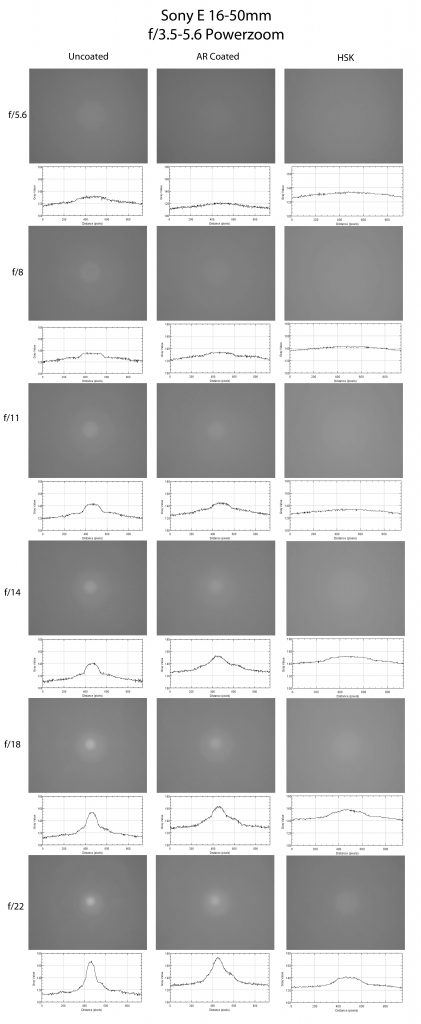
This lens was very interesting in that it formed two distinct hotspots. The AR coating reduced the intensity of the small hotspot as well as the wider hotspot. The HSK got rid of the small hotspot, but only reduced the larger hotspot.
Lens based hotspots
We did find that some lenses had a hotspot that our HSK filter did not remove. We suspected that these might not be caused by sensor reflections. To test this, we grabbed the Sony SELP-1650 16-50mm f/3.5-f.6 OSS lens which had two distinct hotspots, one that the HSK removed, and one that it did not. We brought out our sensor mask again, and tested four conditions. 1. A standard control test of our white screen. 2. Reducing the light reaching the lens by masking the screen. 3. Reducing the light reflecting off the sensor only by masking the sensor, and 4. Reducing the light on both, by masking both the screen and sensor.
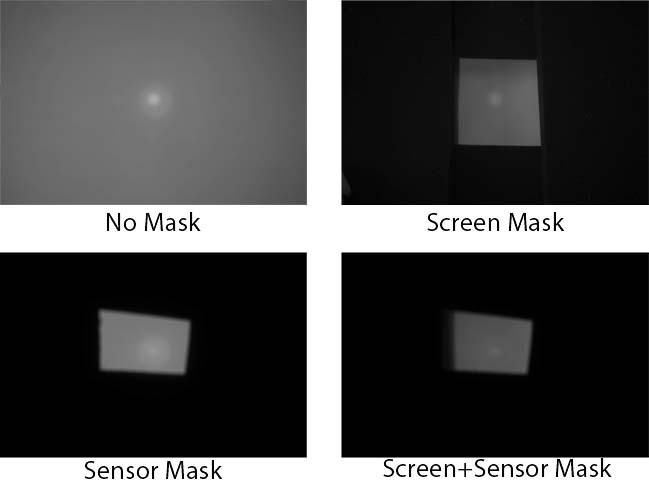
We see exactly what we predict. When we reduce the light reaching the lens, we reduce the larger lens based hotspot. When we reduce the sensor reflection, we reduce the small sensor based hotspot. When we mask both, we reduce both hotspots.
Interestingly, the lens based hotspots have a distinctive intensity trace. In all the ones that we have tested so far, the lens already exhibits light fall out across the frame, compared to a normally flat exposure. The hotspot manifests as a sort of severe vignetting with less defined edges, while the sensor hotspots manifest as sharper spots on lenses with less vignetting to begin with. How many hotspots are caused by lenses vs sensors remains to be seen, but we suspect that older lenses will tend to have more sensor based hotspots, since they were designed in an era where there was no reflective sensor to worry about. Even still, we have shown that several modern lenses have sensor based hotspots.
BONUS
Don’t forget that there are other artifacts out there besides hotspots. In photography, stray reflections are always a bad thing. Here is another kind of reflection you can get off of the sensor. The geometric pattern is a reflection from the CFA grid over the sensor. Our AR coating doesn’t solve this reflection, but the HSK does.

Here is the Minolta lens again from the start of the article, this time in infrared. It still has a hotspot, as well as a few extra reflections. Our AR coated filter removes the extra reflections but not the hotspot, and our HSK filter removes both. Interestingly, our HSK filter also removes the visible light hotspot.

Conclusion
We establish definitively that sensor reflections can contribute to hotspots and establish a methodology to test a lens for hotspot performance. We find that many of the lens hotspots we tested were sensor based and that some appear to be lens based. The lens based hotspots have a vignetting appearance while sensor hotspots are smaller and more defined. We introduce our new patent pending HSK sensor filter that removes sensor based hotspots.
Thank you for reading! Let us know your thoughts in the comments.
 Look familiar? This isn’t an infrared hotspot, it’s actually a visible light hotspot with the Minolta 50mm f/2.8 AF Macro lens.
In 2015 our good friend Tony Kurdzuk pointed out an interesting fact that turned this hypothesis upside down. Being an early adopter of digital, he remembered that early stock digital cameras could sometimes form a hotspot with lenses that were fine with film. This blew our mind; it’s hard to visualize how a sensor reflection could form a focused spot. It seems unintuitive, but when we researched it, there were other reports of this phenomenon. We found one article where the Minolta 5D exhibits a visible light hotspot with certain lenses: Hotspots on early digital cameras. We found other observations that the color of the hotspot was different between cameras, suggesting that different sensor layers were contributing more than others. Mark Hilliard has also observed that many hotspot causing lenses never made hotspots when shooting film. Compared to film, a digital sensor is highly reflective, and it seems like this was potentially causing hotspots. With this evidence, we reasoned that it was possible to reduce hotspots by reducing reflections at the sensor.
Look familiar? This isn’t an infrared hotspot, it’s actually a visible light hotspot with the Minolta 50mm f/2.8 AF Macro lens.
In 2015 our good friend Tony Kurdzuk pointed out an interesting fact that turned this hypothesis upside down. Being an early adopter of digital, he remembered that early stock digital cameras could sometimes form a hotspot with lenses that were fine with film. This blew our mind; it’s hard to visualize how a sensor reflection could form a focused spot. It seems unintuitive, but when we researched it, there were other reports of this phenomenon. We found one article where the Minolta 5D exhibits a visible light hotspot with certain lenses: Hotspots on early digital cameras. We found other observations that the color of the hotspot was different between cameras, suggesting that different sensor layers were contributing more than others. Mark Hilliard has also observed that many hotspot causing lenses never made hotspots when shooting film. Compared to film, a digital sensor is highly reflective, and it seems like this was potentially causing hotspots. With this evidence, we reasoned that it was possible to reduce hotspots by reducing reflections at the sensor.
 When we tested these filters, we found that we were able to reduce hotspots on some lenses, but they were not eliminated. Some lenses would start to show hotspots at later apertures, or in less conditions, but they were ultimately still present in some conditions. We released these AR coated filters in 2016, and feedback from our independant testers were great. Yes, the hotspots were still present, but many lenses had an expanded working range that made them usable in standard shooting conditions. We weren’t quite satisfied and were sure there was more that could be done. For the last two years we have been testing the hotspots in more detail to really understand what causes them and if there is anything that we can do to truly eliminate them. These are our findings
When we tested these filters, we found that we were able to reduce hotspots on some lenses, but they were not eliminated. Some lenses would start to show hotspots at later apertures, or in less conditions, but they were ultimately still present in some conditions. We released these AR coated filters in 2016, and feedback from our independant testers were great. Yes, the hotspots were still present, but many lenses had an expanded working range that made them usable in standard shooting conditions. We weren’t quite satisfied and were sure there was more that could be done. For the last two years we have been testing the hotspots in more detail to really understand what causes them and if there is anything that we can do to truly eliminate them. These are our findings
 In this context, it becomes apparent that adding an AR coating to the top layer still leaves a lot of reflective surfaces. While we were able to reduce the >90% of the reflection off of the top layer with the AR coating, we have only reduced the total reflections by about 30%. We took apart a sensor to examine how bad the reflections actually were, and we found that while a modern sensor is not highly reflective in visible light, it is still highly reflective in infrared.
In this context, it becomes apparent that adding an AR coating to the top layer still leaves a lot of reflective surfaces. While we were able to reduce the >90% of the reflection off of the top layer with the AR coating, we have only reduced the total reflections by about 30%. We took apart a sensor to examine how bad the reflections actually were, and we found that while a modern sensor is not highly reflective in visible light, it is still highly reflective in infrared.
 Here is the coverglass layer, shot in visible on the left and infrared on the right. In IR the reflections are much more prominent.
Here is the coverglass layer, shot in visible on the left and infrared on the right. In IR the reflections are much more prominent.
 Here is the bare camera sensor, shot again in visible on the left and infrared on the right. You can see a dramatic difference in reflection; under visible light the sensor has no observable reflections. In IR, the sensor is highly reflective.
Here is the bare camera sensor, shot again in visible on the left and infrared on the right. You can see a dramatic difference in reflection; under visible light the sensor has no observable reflections. In IR, the sensor is highly reflective.



 Going from top to bottom, the aperture gets smaller and the hotspot gets more pronounced. Going from left to right, the light decreases and the hotspot gets dimmer. This should produce a rough triangle of conditions with visible hotspots. The bigger this triangle, the more common and noticeable a hotspot will be. Below is another test with our AR coated filter. While the reduction is modest in the left most column, looking at the rest of the pictures it is quite obvious how much the useable range of the lens has improved.
Going from top to bottom, the aperture gets smaller and the hotspot gets more pronounced. Going from left to right, the light decreases and the hotspot gets dimmer. This should produce a rough triangle of conditions with visible hotspots. The bigger this triangle, the more common and noticeable a hotspot will be. Below is another test with our AR coated filter. While the reduction is modest in the left most column, looking at the rest of the pictures it is quite obvious how much the useable range of the lens has improved.

 Since the hotspot is a focused spot, we reasoned that if the hotspot originated in the lens and focused onto the center of the sensor, the mask would not do anything to block this light, and the hotspot would look the same. If the hotspot originates as sensor reflections, this mask would block most of the reflections coming from the sensor and reduce the hotspot. We observe the latter, and the sensor mask is able to reduce hotspots.
Since the hotspot is a focused spot, we reasoned that if the hotspot originated in the lens and focused onto the center of the sensor, the mask would not do anything to block this light, and the hotspot would look the same. If the hotspot originates as sensor reflections, this mask would block most of the reflections coming from the sensor and reduce the hotspot. We observe the latter, and the sensor mask is able to reduce hotspots.
 Here you can see our results. Keeping the aperture and exposure consistent, the hotspot intensity is reduced by the sensor mask.
Here you can see our results. Keeping the aperture and exposure consistent, the hotspot intensity is reduced by the sensor mask.
 Comparing the not coated camera to the AR coated camera, you can see a clear improvement with the AR coating in the wider apertures. At smaller apertures, both have a visible hotspot, but looking at the line graph shows that the hotspot is still less intense in the AR coated version. But more importantly, ladies and gentlemen, we present to you a fully eliminated hotspot with the HSK filter! Even at f22, this lens has no trace of a hotspot.
Comparing the not coated camera to the AR coated camera, you can see a clear improvement with the AR coating in the wider apertures. At smaller apertures, both have a visible hotspot, but looking at the line graph shows that the hotspot is still less intense in the AR coated version. But more importantly, ladies and gentlemen, we present to you a fully eliminated hotspot with the HSK filter! Even at f22, this lens has no trace of a hotspot.
 Here the AR coating does not show much improvement, but the hotspot is gone with the HSK filter.
Here the AR coating does not show much improvement, but the hotspot is gone with the HSK filter.
 With this lens, the HSK didn’t kill the hotspot, but it is reduced.
With this lens, the HSK didn’t kill the hotspot, but it is reduced.
 This lens was very interesting in that it formed two distinct hotspots. The AR coating reduced the intensity of the small hotspot as well as the wider hotspot. The HSK got rid of the small hotspot, but only reduced the larger hotspot.
This lens was very interesting in that it formed two distinct hotspots. The AR coating reduced the intensity of the small hotspot as well as the wider hotspot. The HSK got rid of the small hotspot, but only reduced the larger hotspot.
 We see exactly what we predict. When we reduce the light reaching the lens, we reduce the larger lens based hotspot. When we reduce the sensor reflection, we reduce the small sensor based hotspot. When we mask both, we reduce both hotspots.
Interestingly, the lens based hotspots have a distinctive intensity trace. In all the ones that we have tested so far, the lens already exhibits light fall out across the frame, compared to a normally flat exposure. The hotspot manifests as a sort of severe vignetting with less defined edges, while the sensor hotspots manifest as sharper spots on lenses with less vignetting to begin with. How many hotspots are caused by lenses vs sensors remains to be seen, but we suspect that older lenses will tend to have more sensor based hotspots, since they were designed in an era where there was no reflective sensor to worry about. Even still, we have shown that several modern lenses have sensor based hotspots.
We see exactly what we predict. When we reduce the light reaching the lens, we reduce the larger lens based hotspot. When we reduce the sensor reflection, we reduce the small sensor based hotspot. When we mask both, we reduce both hotspots.
Interestingly, the lens based hotspots have a distinctive intensity trace. In all the ones that we have tested so far, the lens already exhibits light fall out across the frame, compared to a normally flat exposure. The hotspot manifests as a sort of severe vignetting with less defined edges, while the sensor hotspots manifest as sharper spots on lenses with less vignetting to begin with. How many hotspots are caused by lenses vs sensors remains to be seen, but we suspect that older lenses will tend to have more sensor based hotspots, since they were designed in an era where there was no reflective sensor to worry about. Even still, we have shown that several modern lenses have sensor based hotspots.
 Here is the Minolta lens again from the start of the article, this time in infrared. It still has a hotspot, as well as a few extra reflections. Our AR coated filter removes the extra reflections but not the hotspot, and our HSK filter removes both. Interestingly, our HSK filter also removes the visible light hotspot.
Here is the Minolta lens again from the start of the article, this time in infrared. It still has a hotspot, as well as a few extra reflections. Our AR coated filter removes the extra reflections but not the hotspot, and our HSK filter removes both. Interestingly, our HSK filter also removes the visible light hotspot.

